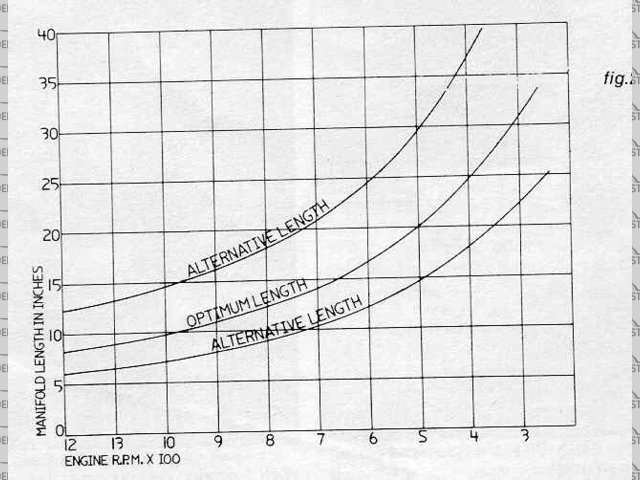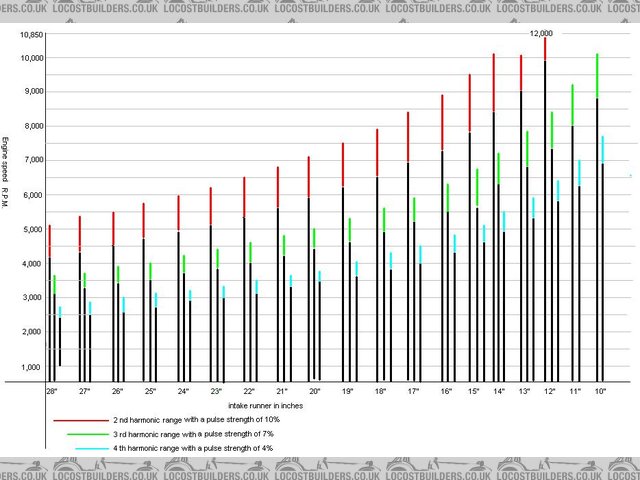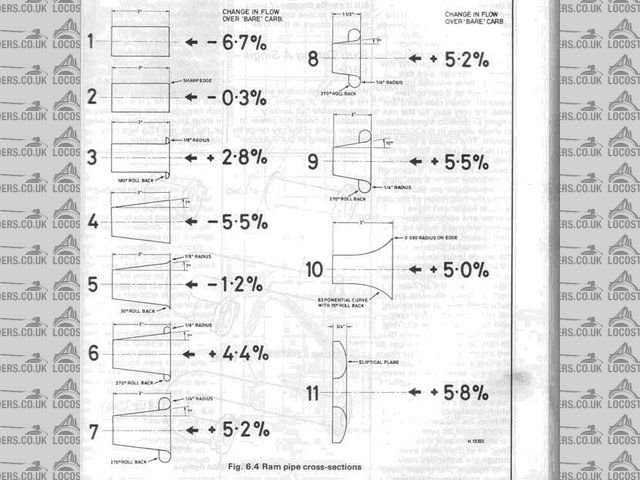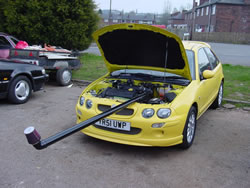carboy0
|
| posted on 6/6/17 at 09:19 PM |

|
|
Tuned length inlets - how to measure
I'm building an engine using bike throttle bodies. I want to tune the length of the inlet to create pressure pulses. I have done the
calculations on the overall ideal length, but I am struggling to measure the first section inside the head as it curves. Do I use the length of the
'long' side of the port or do I use the length of the 'short' side of the port. Or do I average the two together? The
difference is about 20mm.
Any advice welcome.
[Edited on 6/6/17 by carboy0]
Chris
www.marinacoupe.co.uk
|
|
|
|
|
SPYDER
|
| posted on 6/6/17 at 10:04 PM |

|
|
I wouldn't get hung up over a few mms. Variations in charge temperature and density will likely make a minor mockery of your calcs anyway.
Have you seen the following charts?


|
|
|
snapper
|
| posted on 7/6/17 at 05:47 AM |

|
|
The science is deep, I have a set of measurements given to me by a member of Turbosports forum which needed a lot of cam information.
The results he gave me were specific to my engine and gave exhaust and inlet lengths.
If you look at the inlet flow around the valve on a Pinto most of it goes the straighter path over the valve head on the long side of the port so I
would calculate the length using the middle of the port an average of the 2 distances.
Tuning at this level is never about just 1 element so I assume you have fitted bigger valves to a ported head and used waisted stem valves?
I eat to survive
I drink to forget
I breath to pi55 my ex wife off (and now my ex partner)
|
|
|
Myke 2463
|
| posted on 7/6/17 at 06:43 AM |

|
|
Already been done on a flowbench at Emerald. http://www.emeraldm3d.com/articles/emr-adj-length-intake/
Be Lucky Mike.
|
|
|
carboy0
|
| posted on 7/6/17 at 11:14 AM |

|
|
Thanks guys, that's really useful stuff and having just read the Dave Walker article, he says just a 4mm difference in length can make a
difference to the torque.
I'm going to use the average of the inside and outside port lengths and make up some different straight inlets in 5mm increments around the
theoretical 3rd order pulse length, and get on a rolling road.
I'll post the results once I have got it all together.
Chris
www.marinacoupe.co.uk
|
|
|
MikeRJ
|
| posted on 7/6/17 at 02:21 PM |

|
|
quote:
Originally posted by Myke 2463
Already been done on a flowbench at Emerald. http://www.emeraldm3d.com/articles/emr-adj-length-intake/
Look at the kind of inlet lengths you need to make effective gains, compared to the ultra short inlet lengths used on many/most locosts with e.g. bike
carbs or the Griffin style steel plenums.
|
|
|
snapper
|
| posted on 7/6/17 at 03:10 PM |

|
|
Inlet to valve measurement if from intake bell to valve head so you can just extend/reduce trumpet length to get near optimum
Don't forget rolled ends

I eat to survive
I drink to forget
I breath to pi55 my ex wife off (and now my ex partner)
|
|
|
ettore bugatti
|
| posted on 7/6/17 at 09:58 PM |

|
|
I would use the average length in the intake port, but basically fit the longest runner physically possible.
The 5mm variation can be used to smooth the curve out.
Open the following graphs in seperate tabs and toggle in between to see the differences.
http://www.emeraldm3d.com/media/projects/perfect_flow/50vs80_b.JPG
http://www.emeraldm3d.com/media/projects/perfect_flow/155vs170_b.JPG
The 155mm makes more torque than the 80mm, although the 80mm has a smoother curve. Luckily you can have your cake and eat it. So put 170mm in.
|
|
|
SPYDER
|
| posted on 8/6/17 at 08:38 AM |

|
|
quote:
Originally posted by ettore bugatti
... but basically fit the longest runner physically possible.
Like this, you mean?

A little experiment carried out by Pete Burgess presumably whilst under the influence!
There's more on his website.
|
|
|
carboy0
|
 posted on 8/6/17 at 09:13 AM posted on 8/6/17 at 09:13 AM |

|
|
Fun, but not quite.
[Edited on 8/6/17 by carboy0]
Chris
www.marinacoupe.co.uk
|
|
|
SPYDER
|
| posted on 8/6/17 at 09:33 AM |

|
|
If you fit the longest runners you can under a typical "7" bonnet they'll be about 14".
Mine are about 14" which, if the diagrams above are to be believed, gives some pulse tuning benefit at around 7k and 5K revs.
Just the areas for peak power and peak torque on many engines.
|
|
|
Ugg10
|
| posted on 8/6/17 at 03:33 PM |

|
|
there's some general rule of thumb dimensions on the Jenvey site as well.
http://www.jenvey.co.uk/faq/general-faq
For my 1.7 Zetec SE (150hp at 7000rpm) looks like I need something like -
35mm butterflies (got 42mm ???)
450mm (18" trumpet inlet to valve distance - interesting this is different to the 14" from the graph earlier in the thread. I am guessing
one is tuned to the 2nd harmonic at approx. 7k rpm and one the third going by the graph. trumpet inlet to valve distance - interesting this is different to the 14" from the graph earlier in the thread. I am guessing
one is tuned to the 2nd harmonic at approx. 7k rpm and one the third going by the graph.
200mm (8" Valve to butterfly distance Valve to butterfly distance
Injectors currently in stick position, in head firing at the back of the valve - good for low rpm control and emissions
Will have to get the tape measure out.

---------------------------------------------------------------
1968 Ford Anglia 105e, 1.7 Zetec SE, Mk2 Escort Workd Cup front end, 5 link rear
Build Blog - http://Anglia1968.weebly.com
|
|
|













